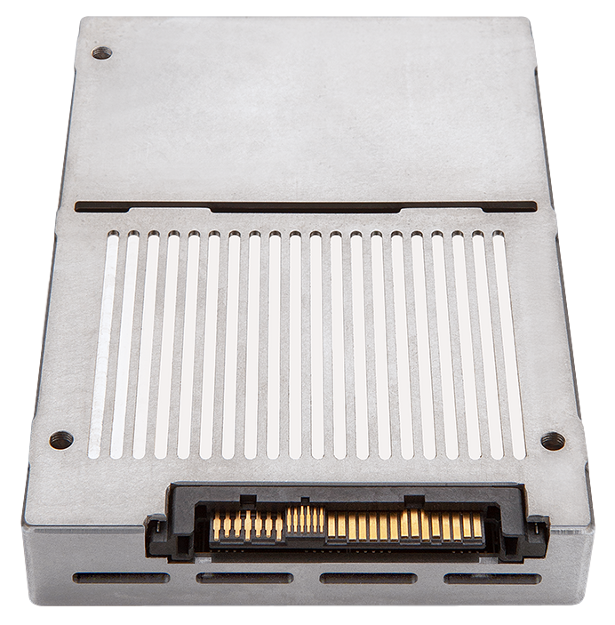Radian Memory Systems is announcing the industry’s first Open-Channel 2-compliant solid-state drive (SSD). The U.2 form factor RMS-350 offers up to 12TB of Flash, and is unique in including up to 12GB of byte-addressable, PMR style user NV-RAM. The RMS-350 is targeted toward All-Flash Arrays, cloud storage and hyperconverged systems and offers highly parallelized, deterministic input/output (I/O), and minimizes tail latencies in data center workloads. Also included is support for Cooperative Flash Management (CFM) based on Radian’s Symphonic CFM technology on Radian’s implementation of the latest Open-Channel 2 interface. Variations of software-defined, Open-Channel SSDs are appearing throughout the hyperscale market. Early versions were deployed by Baidu and Alibaba in China, with other variants, such as Microsoft Azure’s “Project Denali”, anticipated to become available within the next 12 months.
 According to Mike Jadon, Radian’s CEO, “With the RMS-350, we’re leveraging some of our innovative Cooperative Flash Management functionality to bring data center functionality into an SSD with an Open-Channel 2-compliant interface.” Although Radian has had this functionality available for several years in their Symphonic line of SSDs, the RMS-350 is the first SSD to include CFM and numerous other features in an SSD that utilizes an Open-Channel 2-compliant interface.
According to Mike Jadon, Radian’s CEO, “With the RMS-350, we’re leveraging some of our innovative Cooperative Flash Management functionality to bring data center functionality into an SSD with an Open-Channel 2-compliant interface.” Although Radian has had this functionality available for several years in their Symphonic line of SSDs, the RMS-350 is the first SSD to include CFM and numerous other features in an SSD that utilizes an Open-Channel 2-compliant interface.
 Software and firmware features include ‘Idealized Flash’, ASL Configurator, Cooperative and ‘Decoupled’ Wear Leveling, and Cooperative and ‘Decoupled’ NAND Maintenance. With ‘Idealized Flash’, geometry emulation abstracts NAND geometry and vendor-specific attributes. It also maintains alignment to the physical memory array and abstracts the device’s internal management of bad blocks. It presents only ‘Idealized Flash’ to the host.
Software and firmware features include ‘Idealized Flash’, ASL Configurator, Cooperative and ‘Decoupled’ Wear Leveling, and Cooperative and ‘Decoupled’ NAND Maintenance. With ‘Idealized Flash’, geometry emulation abstracts NAND geometry and vendor-specific attributes. It also maintains alignment to the physical memory array and abstracts the device’s internal management of bad blocks. It presents only ‘Idealized Flash’ to the host.
Address Space Layout Configurator presents the host with contiguous logical addressing (no gaps) for direct access by modern host software stacks. It is able to subdivide NAND memory into ‘iso-boxes’ that appear to the host as independent block devices, and it optimizes the opposing performance and efficiency tradeoffs that are unique to flash memory.
 With Cooperative and ‘Decoupled’ Wear Leveling, the controller generates wear-related metrics and makes them accessible to the host. It is able to use different host-owned, memory controller-owned and shared cooperative modes to offload and simplify host-controlled wear leveling. This also enables vendor-supported warranties.
With Cooperative and ‘Decoupled’ Wear Leveling, the controller generates wear-related metrics and makes them accessible to the host. It is able to use different host-owned, memory controller-owned and shared cooperative modes to offload and simplify host-controlled wear leveling. This also enables vendor-supported warranties.
Cooperative and ‘Decoupled’ NAND Maintenance allows the device to handle low level NAND maintenance activities for data retention and to prevent disruptions. These activities are performed cooperatively under deterministic host scheduling to minimize unpredictable latency spikes.
The RMS-350 is being offered in capacities of 3TB, 6TB and 12TB, along with either 4GB or 12GB of PMR style User NV-RAM. The NVMe PCIe Gen3 interface supports either single port x4 or dual port 2×2 lane configurations. The drive utilizes enterprise-grade TLC NAND (eTLC) and is supported with robust LDPC error correction. The 4GB or 12GB of PMR style User NV-RAM offers functionality that is similar to that of an on-board NV-DIMM-N, but unlike NV-DIMM, scales with Flash capacity as drives are added to the system, and without requiring cabling for capacitor packs. This NV-RAM appears to the host as an independent NVMe block device that is accessible via NVMe, or memory mapped (mmap) as byte-accessible (dword) memory for Programmed I/O (PIO).
 The RMS-350’s high availability is enabled by features such as dual port, hot plug/surprise remove, fault tolerant memory management, and complete diagnostic lifecycle capabilities that meet enterprise OEM and data center needs. Radian has RMS-350 evaluation units available for select customers, and anticipates general availability by fall of this year. Radian Memory will also be exhibiting at this year’s Flash Memory Summit in Santa Clara, California, which begins on August 7th.
The RMS-350’s high availability is enabled by features such as dual port, hot plug/surprise remove, fault tolerant memory management, and complete diagnostic lifecycle capabilities that meet enterprise OEM and data center needs. Radian has RMS-350 evaluation units available for select customers, and anticipates general availability by fall of this year. Radian Memory will also be exhibiting at this year’s Flash Memory Summit in Santa Clara, California, which begins on August 7th.
 The SSD Review The Worlds Dedicated SSD Education and Review Resource |
The SSD Review The Worlds Dedicated SSD Education and Review Resource | 